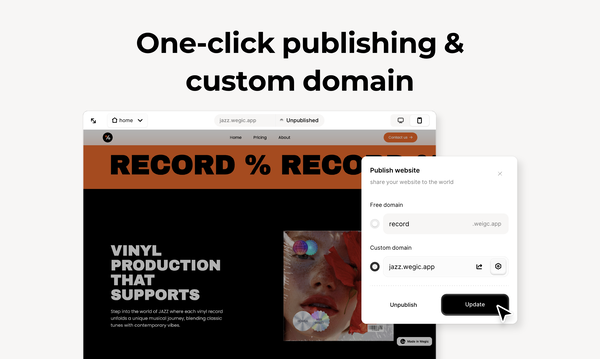A Beginner’s Guide to Web Wireframe Tool
Web Wireframe Tool Solutions
Web Wireframe Tool
Web development tools are essential for creating, debugging, and optimizing websites. They help developers streamline their workflow and improve efficiency by providing tools for coding, testing, and monitoring websites. In this article, we will discuss some of the most popular web development tools used by developers.

A Beginner’s Guide to Web Wireframe Tool
Web Wireframe Tool
AI web developers are at the forefront of the technological revolution, as they leverage AI technologies to create smarter and more intuitive websites. These professionals have a deep understanding of AI algorithms, machine learning, natural language processing, and other AI technologies that enable them to create websites that can think, learn, and adapt to user preferences.
One of the key skills of an AI web developer is the ability to understand and implement AI algorithms. These algorithms are the foundation of AI technologies and enable websites to perform tasks such as personalized recommendations, natural language processing, image recognition, and more. AI web developers must have a strong grasp of these algorithms and be able to apply them effectively to create intelligent websites.
In addition to AI algorithms, AI web developers must also have expertise in machine learning. Machine learning is a subset of AI that enables computers to learn from data and improve their performance over time. By leveraging machine learning techniques, AI web developers can create websites that can analyze user behavior, predict user preferences, and provide personalized recommendations.
Another key skill of an AI web developer is proficiency in natural language processing (NLP). NLP is a branch of AI that enables computers to understand and interpret human language. AI web developers use NLP techniques to create websites that can interact with users in a more natural and intuitive way, such as chatbots and virtual assistants.
AI web developers also need to have a strong foundation in web development technologies such as HTML, CSS, JavaScript, and backend programming languages like Python or Java. These technologies are essential for building the structure and functionality of websites, and AI web developers must be able to integrate AI technologies seamlessly into the website’s architecture.
AI web developers are changing the landscape of web development by creating websites that are more intelligent, personalized, and user-friendly. These professionals are at the forefront of innovation, pushing the boundaries of what is possible in web development. By leveraging AI technologies, AI web developers are creating websites that can adapt to user preferences, provide personalized recommendations, and even anticipate user needs before they are expressed.
First and foremost, it’s important to understand the different types of web hosting available. The most common types of web hosting are shared hosting, VPS (Virtual Private Server) hosting, dedicated hosting, and cloud hosting.
Shared hosting is the most basic and cost-effective form of web hosting, where multiple websites are hosted on a single server. This means that resources such as storage, bandwidth, and processing power are shared among all websites on the server. While shared hosting is suitable for smaller websites with low to moderate traffic, it may not be the best option for high-traffic or resource-intensive websites.
VPS hosting is a step up from shared hosting, where a physical server is divided into virtual servers, each with its own dedicated resources. This provides more control and flexibility compared to shared hosting, making it a good option for websites that require more resources but do not need a dedicated server.
Dedicated hosting involves renting an entire server for your website, giving you complete control over resource allocation and security. This type of hosting is ideal for high-traffic websites or e-commerce sites that require robust security and performance.
Cloud hosting is a newer form of web hosting that utilizes multiple interconnected servers to provide scalable and reliable hosting services. With cloud hosting, resources are distributed across multiple servers, ensuring high uptime and performance. Cloud hosting is suitable for websites that experience fluctuating traffic or unpredictable resource demands.
When comparing web hosting providers, there are several factors to consider:
1. Uptime and reliability: Look for a web hosting provider with a high uptime guarantee, ideally 99.9% or higher. A reliable hosting provider will ensure that your website is always accessible to users.
2. Performance and speed: Choose a hosting provider that offers fast loading times and efficient server performance. Slow-loading websites can deter users and negatively impact your search engine rankings.
3. Security: Make sure the hosting provider offers robust security measures, such as SSL certificates, regular backups, and malware protection, to protect your website from cyber threats.
4. Scalability: Consider whether the hosting provider offers scalability options that allow you to easily upgrade your hosting plan as your website grows.
5. Customer support: Look for a hosting provider that offers responsive customer support, preferably 24/7, to address any technical issues or concerns that may arise.
Now, let’s compare some popular web hosting providers:
1. Bluehost: Bluehost is a well-known web hosting provider that offers a range of hosting options, including shared, VPS, and dedicated hosting. Bluehost is known for its reliable uptime, fast loading times, and excellent customer support. Pricing starts at $2.95 per month for shared hosting.
2. SiteGround: SiteGround is another popular web hosting provider that is known for its high performance, security features, and responsive customer support. SiteGround offers shared, VPS, and cloud hosting options, with pricing starting at $6.99 per month for shared hosting.
3. HostGator: HostGator is a budget-friendly web hosting provider that offers a variety of hosting plans, including shared, VPS, and dedicated hosting. HostGator is known for its easy-to-use interface, uptime guarantee, and affordable pricing. Shared hosting plans start at $2.75 per month.
4. A2 Hosting: A2 Hosting is a high-performance web hosting provider that offers a range of hosting options, including shared, VPS, and dedicated hosting. A2 Hosting is known for its fast loading times, excellent uptime, and developer-friendly features. Shared hosting plans start at $2.99 per month.
5. InMotion Hosting: InMotion Hosting is a reliable web hosting provider that offers a variety of hosting plans, including shared, VPS, and dedicated hosting. InMotion Hosting is known for its fast loading times, excellent customer support, and free website migration services. Shared hosting plans start at $6.99 per month.

A Beginner’s Guide to Web Wireframe Tool
Web Wireframe Tool
In conclusion, designing a website layout template is a crucial step in creating a successful website. By considering factors such as the overall structure of the site, the placement of elements, the use of white space, and the responsive nature of the design, you can create a layout that is visually appealing, easy to navigate, and user-friendly. Experiment with different layouts and elements to find the one that works best for your site, and don’t be afraid to make changes as needed. With a well-designed layout, you can create a website that engages users and keeps them coming back for more.


